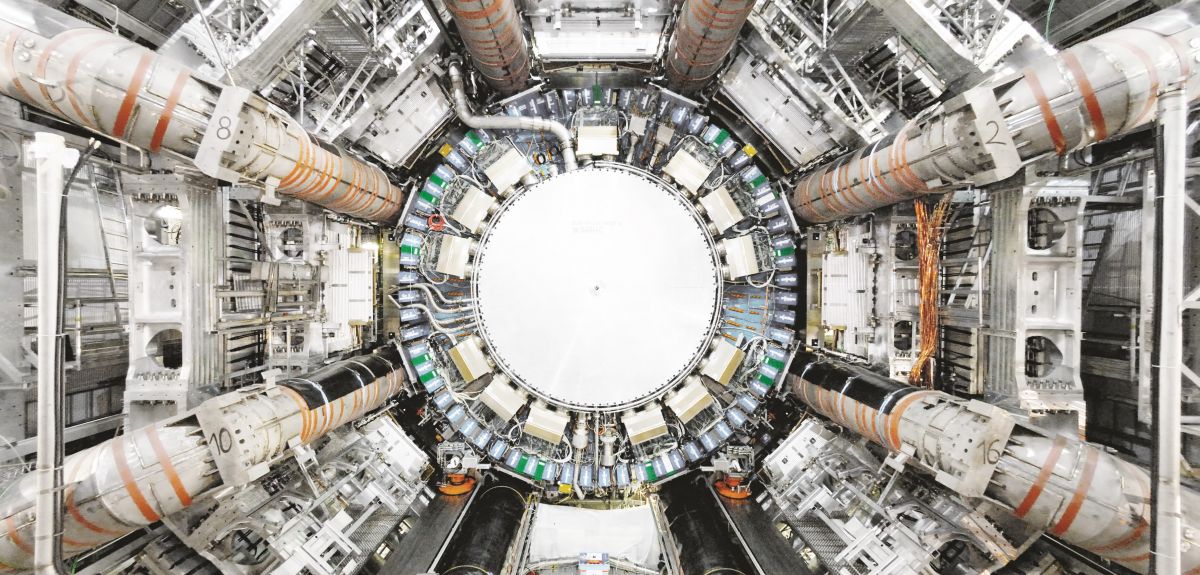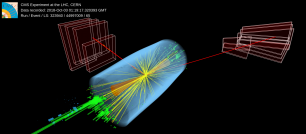
Credit: Claudia Marcelloni/CERN
Oxford scientists at CERN help take one step closer to understanding the Higgs boson
New results have been announced by particle physicists at CERN, including a team led by Oxford scientists, that will move them closer to understanding the basic forces that shape our universe.
The ATLAS and CMS experiments at CERN’s Large Hadron Collider (LHC) have today announced their observation of a phenomenon that has never been seen before, where the Higgs boson decays into two elementary particles, called muons.
Giacomo Artoni, a postdoctoral fellow at Oxford University Department of Physics and one the leaders of the ATLAS analysis, said: ‘Searching for the Higgs decaying into muons is a great challenge, like searching for a needle in a haystack. This is only possible thanks to the amazing performance of the LHC and the ATLAS detector, and the great work of the many UK institutes involved.’
Professor Ian Shipsey, Head of Physics at Oxford University, said: 'Muons are a remarkably simple and powerful discovery tool. Focusing on muons we have been building specialised cameras to take snapshots of them since I was a graduate student, and then interpreting those snapshots using advanced statistical techniques to learn more about the universe. This has been productive and successful line of inquiry. I brought it with me when I joined Oxford in 2013 and had the opportunity to hone muons as a discovery tool on ATLAS since 2015 with Giacomo, a number of wonderful graduate students including Luigi Marchese, Miha Zgubic whose thesis is about the search for Higgs to two muons, Ricardo Wolker, Yingjie Wei and Siyuan Yan and Professor Daniela Bortoletto.'

Event in which a candidate Higgs boson produced by vector boson fusion (VBF) decays into two muons. The forward jets from the VBF are depicted by the orange cones and the muons are drawn as long red lines.
Credit: CMS Collaboration
UK institutes have been members of the ATLAS and CMS collaborations since their very inception and part of the design, build and current operation of these huge detectors.
Watch Oxford at CERN:
The Higgs boson discovery in 2012 at the LHC famously provided evidence for a missing piece in the Standard Model of Particle Physics that describes how elementary particles acquire mass. In terms of our understanding of matter and the basic forces shaping the Universe, this is a critical issue: without mass, there would be no matter as we know it.
Since its discovery, the Higgs boson has been scrutinized by physicists eager to discover whether this particle behaves exactly as expected within the Standard Model or whether its properties will reveal yet more insight into the many mysteries that remain to be explained in fundamental physics. The decay of a Higgs boson to muons provides a new chapter to the exploration of its properties.
Karl Jakobs, ATLAS spokesperson, said: 'This evidence of Higgs boson decays to second-generation matter particles complements a highly successful Run 2 Higgs physics programme. The measurements of the Higgs boson’s properties have reached a new stage in precision and rare decay modes can be addressed. These achievements rely on the large LHC dataset, the outstanding efficiency and performance of the ATLAS detector, as well as the use of novel analysis techniques.'
Professor Claire Shepherd-Themistocleous from STFC’s Rutherford Appleton Laboratory and UK CMS Spokesperson, said: ‘The extraordinary capabilities of the CMS experiment and the ingenuity of the members of the collaboration from around the world, including, of course, the UK, have once again produced a beautiful result.
‘The observation of Higgs boson decays to the second generation of fundamental particles enables tests of the standard model and opens up a new avenue of exploration for evidence of physics beyond our current understanding.
‘Muons, like electrons, are elementary particles that make up matter. While electrons are classified as a first-generation particle, muons belong to the second generation. The physics process of the Higgs boson decaying into muons is a rare phenomenon, as only about one Higgs boson in 5000 decays into muons. These new results have pivotal importance for CERN’s physics programme because they indicate for the first time that the Higgs boson interacts with second generation elementary particles.’
Oxford is a founding member of ATLAS. The current group members comprise (in addition to those named above): Professors Alan Barr, Claire Gwenlan, Chris Hays, Todd Huffman, Richard Nickerson, Tony Weidberg, and Georg Viehauser. Senior Researchers James Frost, Elizabeth Gallas, Richard Plackett and Karolos Potiamanos. Researchers Bill Balunas, Lydia Beresford, Claudia Merlassino, Koichi Nagai, Elizabeth Schopf and everyone else here including the students.
Find out more about this result from CERN and see the full, published results here: https://home.cern/news/press-release/physics/cern-experiments-announce-first-indications-rare-higgs-boson-process
Discover more about Oxford’s integral relationship with CERN: https://medium.com/oxford-university/science-for-peace-oxford-at-cern-1f9f10afcced
 Cambridge victorious in Women's and Men's Boat Races 2025
Cambridge victorious in Women's and Men's Boat Races 2025
 Expert Comment: Ethical and legal challenges of uterus transplants in Mexico
Expert Comment: Ethical and legal challenges of uterus transplants in Mexico
 Oxford Humanities team delivers framework for tackling modern slavery and human trafficking
Oxford Humanities team delivers framework for tackling modern slavery and human trafficking